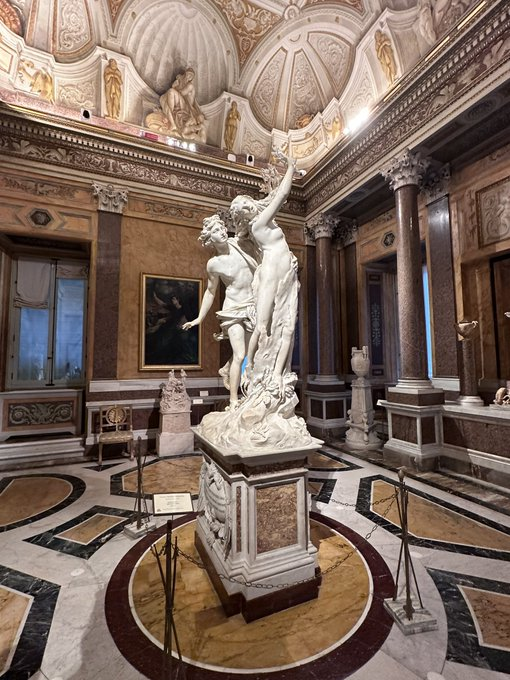The artworks inspired by Ovid's "Metamorphoses" confront us with an unsettling truth: life is defined by unending change and disorder.
They challenge us to find beauty in impermanence, questioning our very essence.
Let's delve into these masterpieces inspired by Ovid: 🧵⤵️
They challenge us to find beauty in impermanence, questioning our very essence.
Let's delve into these masterpieces inspired by Ovid: 🧵⤵️

1. "Apollo and Daphne" by Gian Lorenzo Bernini (1622-1625): Bernini's masterpiece vividly brings to life the moment Daphne is transformed into a laurel tree to escape Apollo, capturing the drama and emotion of Ovid's tale with detail and dynamic movement. 

2. "The Rape of Europa" by Titian (1562): This painting depicts the story of Jupiter's seduction of Europa in the form of a bull. Titian's mastery of color and form, along with the sensuous and dramatic depiction of the myth, makes this work a quintessential representation of Ovid's influence.

3. "Diana and Actaeon" by Titian (1556-1559): This work captures the moment Actaeon stumbles upon the goddess Diana bathing. The painting is celebrated for its composition, the depiction of the figures, and the landscape that evokes the tragic and sudden nature of Actaeon's metamorphosis.

4. "Narcissus" by Caravaggio (c. 1597-1599): Caravaggio's treatment of Narcissus, who falls in love with his own reflection, is a study in light, shadow, and reflection, beautifully capturing the youth's self-absorption and the moment of his impending transformation. 

5. "Venus and Adonis" by Peter Paul Rubens (c. 1635): Rubens' dynamic and emotive style brings to life the doomed love affair between Venus and Adonis, with vibrant colors and brushwork that emphasize the tragedy and passion of their story. 

6. "Perseus and Andromeda" by Peter Paul Rubens (c. 1620-1621): This painting depicts the moment Perseus saves Andromeda from the sea monster. Rubens' mastery of the human form and his use of color and composition convey the heroism and romance of the myth. 

7. "The Metamorphosis of Narcissus" by Salvador Dalí (1937): Dalí's surrealism transforms Narcissus into a flower within a dream, masterfully blending the subconscious and myth through vivid imagery and symbolism. 

8. "Bacchus and Ariadne" by Titian (1522-1523): This work vividly portrays Bacchus falling for Ariadne, using rich colors and lively composition to highlight the scene's emotional depth and festivity. 

9. "Jupiter and Io" by Correggio (c. 1530): In this sensuous painting, Jupiter, in the form of a cloud, embraces Io. Correggio's use of light and shadow, along with the tender expression of the figures, beautifully conveys the divine seduction. 

10. "Landscape with the Fall of Icarus" by Pieter Bruegel the Elder (c. 1560): Bruegel's work echoes 'Metamorphoses'' theme of ambition and consequence. Its intricate landscape and everyday scenes contrast with Icarus's tragedy, underscoring the world's indifference. 

11. Pygmalion adoring his statue by Jean Raoux (1717):
The painting captures the moment of Pygmalion's profound love for his creation, blending the boundaries between art and life, and highlighting the transformative power of love, a theme central to Ovid's 'Metamorphoses.'
The painting captures the moment of Pygmalion's profound love for his creation, blending the boundaries between art and life, and highlighting the transformative power of love, a theme central to Ovid's 'Metamorphoses.'

As a bonus, here is an inspired contemporary sculpture, Narcisus, by the Italian Jacopo Cardillo or Jago as he is known.
Jago's marble sculpture “Narciso” draws inspiration from the Greek myth of Narcissus, a youth who fell in love with his own reflection. The artwork features two figures and delves into the mystery of what Narcissus might have actually seen in the water. Perhaps he saw someone else.
Jago's marble sculpture “Narciso” draws inspiration from the Greek myth of Narcissus, a youth who fell in love with his own reflection. The artwork features two figures and delves into the mystery of what Narcissus might have actually seen in the water. Perhaps he saw someone else.

These artworks affirm Ovid's 'Metamorphoses' as a timeless masterpiece of inspiration, capturing the raw complexity of human emotion and the transformative essence of the myths.
If you enjoyed this thread, feel free to share with others.
If you enjoyed this thread, feel free to share with others.

• • •
Missing some Tweet in this thread? You can try to
force a refresh




















